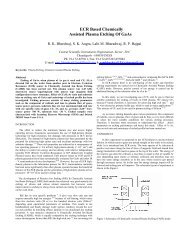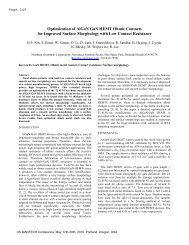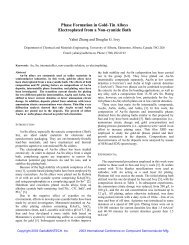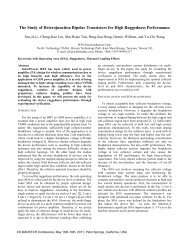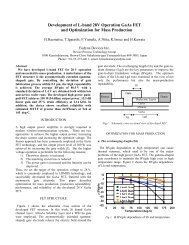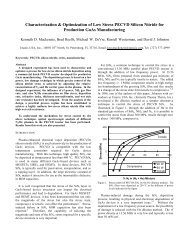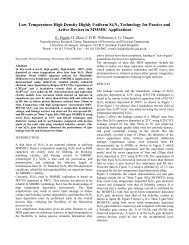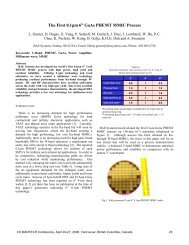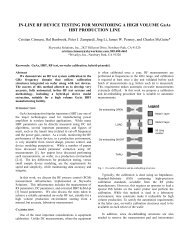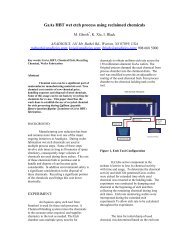GaAs-Wafer Dicing Using the Water jet Guided Laser - CS Mantech
GaAs-Wafer Dicing Using the Water jet Guided Laser - CS Mantech
GaAs-Wafer Dicing Using the Water jet Guided Laser - CS Mantech
- No tags were found...
Create successful ePaper yourself
Turn your PDF publications into a flip-book with our unique Google optimized e-Paper software.
it has two o<strong>the</strong>r primary effects. First, it cools <strong>the</strong> materialbetween <strong>the</strong> laser pulses so <strong>the</strong> heat-affected zone isnegligible. Second, thanks to its high momentum, it removesmost of <strong>the</strong> molten material generated by laser ablation.Additionally, a thin water film on <strong>the</strong> material preventsparticles from adhering to <strong>the</strong> wafer surface. The <strong>Laser</strong>-Micro<strong>jet</strong> is <strong>the</strong>refore significantly different from <strong>the</strong> drylaser, which pose <strong>the</strong> major disadvantages of contaminationand heat damage.FIGURE 228-UM WIDE THROUGH-CUT IN A 100-UM THICK GAAS WAFER: A CHIPPING-FREE CUTThe <strong>Laser</strong>-Micro<strong>jet</strong> also offers advantages over abrasivesawing. It is a faster process; depending on <strong>the</strong> material, upto 10 times faster. Fur<strong>the</strong>rmore, <strong>the</strong> mechanical force appliedby <strong>the</strong> water <strong>jet</strong> is negligible (less than 0.1 N), in contrary tosawing. This force is also much lower than <strong>the</strong> force appliedby <strong>the</strong> assist gas in conventional dry laser cutting.The <strong>Laser</strong>-Micro<strong>jet</strong> is <strong>the</strong>refore an efficient technologyfor semiconductor processing, including III-V compositematerials as well as silicon. Its main applications in this fieldare thin wafer dicing (through-cutting), scribing and edgegrinding. Recent developments on nozzles have enabledstable cutting with a micro-<strong>jet</strong> as thin as 25 µm.The main advantages of <strong>GaAs</strong> cutting with <strong>the</strong> <strong>Laser</strong>-Micro<strong>jet</strong> are: high speed; no mechanical forces; no crackingor chipping; low kerf width; no contamination; no toxicproducts; and possibility to cut through back metal. Inaddition, it can cut at 45° to <strong>the</strong> standard crystal orientation.Omni-directional cutting offers <strong>the</strong> desirable application ofedge grinding of thin wafers. Thus, by removing <strong>the</strong> edge ofwafers, micro-cracks generated by back grinding areeliminated, <strong>the</strong>reby reducing wafer breakage.GAAS WAFER CUTTING AND LASER-MICROJETUsually, <strong>the</strong> <strong>Laser</strong>-Micro<strong>jet</strong> is applied for throughcutting.Figure 2 shows <strong>the</strong> typical quality obtained with <strong>the</strong>LMJ process on <strong>GaAs</strong> wafer. There is no chipping due tomechanical stress and very low contamination. For this 100-µm thick <strong>GaAs</strong> wafer, a fiber laser (wavelength 1064 nm,average power 100 W) has been coupled into a thin water <strong>jet</strong>(diameter 27 µm). These parameters were chosen to obtainhigh cut quality at high speed. Speeds up to 80 mm/s havebeen achieved.1) Particle contamination: <strong>the</strong> <strong>Laser</strong>-Micro<strong>jet</strong> produceslittle contamination, since <strong>the</strong> water <strong>jet</strong> used to guide <strong>the</strong>laser beam onto <strong>the</strong> work piece also efficiently removesmost of <strong>the</strong> molten material. An additional device hasrecently been developed to reduce particle contaminationlevel even fur<strong>the</strong>r. During cutting, a continuous water layerof controlled thickness covers <strong>the</strong> wafer, preventing <strong>the</strong>particles from attaching to <strong>the</strong> material surface. Removing<strong>the</strong> water layer containing suspended particles after cuttingguarantees a clean wafer. The result is especially impressivecompared to conventional laser cutting. Figure 3 provides anexample of <strong>the</strong> cut quality. For this 100-µm thick wafer, aQ-switched Nd:YAG laser (wavelength 1064 nm, averagepower 50 W) has been coupled into a water <strong>jet</strong> of 25 µmdiameter. Even at high speed (60 mm/s), <strong>the</strong> cut quality isexcellent.FIGURE 326-UM WIDE THROUGH-CUT IN A 100-UM THICK GAAS WAFER: A CHIPPING-FREE CUT AT 60 MM/S2) Toxicity of <strong>GaAs</strong> ablation: safety issues are paramountduring cutting since compound <strong>GaAs</strong> contains 51.8%wtarsenic. Tests performed with <strong>the</strong> <strong>Laser</strong>-Micro<strong>jet</strong> (see Table



